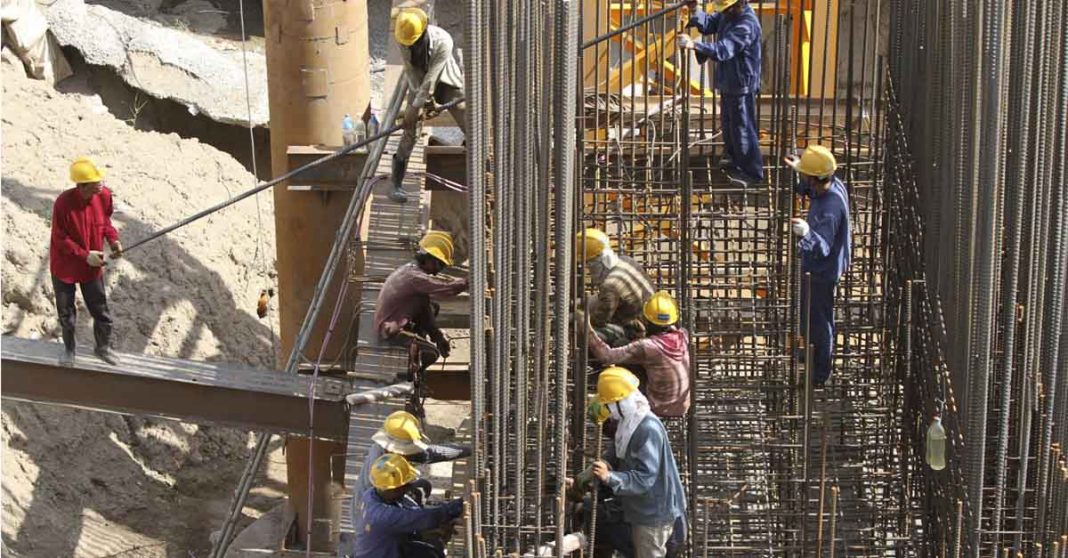Amid the current economic downturn and the cost of living crisis, construction companies in Laos are confronted with a mounting challenge as the local labor force migrates to foreign countries in pursuit of better opportunities, raising concerns about the industry’s future.
A labor crisis has been brewing in Laos since last year, affecting industries ranging from tourism to education, with the depreciation of the local currency, high inflation, and low wages, forcing workers to rethink their futures.
Many workers have made the decision to seek work abroad, either through government-facilitated programs or by other means, in the hope of earning higher wages, allowing them to send funds to their families at home.
According to Pasaxon – the official newspaper of the Lao People’s Revolutionary Party, laborers from Laos primarily migrate to three countries, namely Thailand, Korea, and Japan.
Over the past year, the Ministry of Labor and Social Welfare’s Department of Overseas Employment sent 96,800 laborers to Thailand, around 2,600 laborers to Korea, and 720 workers to Japan as part of their temporary employment abroad initiative.
Bounsouan Xayasin, Head of the Department of Overseas Employment, Ministry of Labour and Social Welfare said in an interview with local media, “Foreign countries offer positions that align well with the knowledge and skills of Lao laborers. These positions come with monthly wages that cover the cost of living and enable workers to save money and send remittances back home as well.”
However, the exodus of workers has created a dire situation for economic development, particularly within the construction industry.
Laos heavily relies on construction workers, with the construction sector constituting approximately 33.6% of the country’s GDP in 2022. However, as workers migrate abroad, Laos continues to lose its skilled labor force, resulting in a growing presence of unskilled workers domestically.
A surge of unskilled workers taking the place of a skilled labor force then puts one of Laos’ pivotal sectors, infrastructure development, at risk due to the former’s lack of experience. This has led to frequent poor-quality projects being completed, requiring extensive post-completion recovery efforts.
In addition to these broader economic implications, the labor shortage crisis has severe repercussions for construction companies operating in Laos.
Athitphathay Chanthabouala, an Architect and Manager at PiSECCON, a disciplinary consulting firm, discussed the impacts of the labor shortage when discussing the issue with the Laotian Times.
“Construction workers receive minimum pay, which is why most of them are constantly seeking job opportunities abroad,” he says.
Since many laborers in Laos are not employed under long-term contracts and instead work on a project-by-project basis, they typically earn a minimum daily wage of around LAK 65,000 (equivalent to USD 3.3).
However, even with recent wage increases, this amount falls short of keeping up with the country’s current inflation rates. In contrast, neighboring countries like Thailand provide laborers with a minimum daily wage of USD 9.6.
Over a one-month period, Lao workers earn a mere USD 66 in their own country, while across the border in Thailand, their counterparts pocket a monthly wage of USD 212 – a staggering 321 percent more each month.
The prospect of earning a higher wage is obviously more appealing, as Saengphet Xayasane, a Lao laborer working in Udon Thani, Thailand, told the Laotian Times.
“The current economic situation in Laos is dire, and the pay is low. There are many more benefits here as a laborer in Thailand, where I can earn up to THB 500 (USD 14.25) per day,” he said.
While not everyone may have the opportunity to work in Thailand, Lao workers are keen to be compensated fairly due to the rising depreciation of the Lao Kip.
Athitphahay explained, “Workers want to earn wages in foreign currencies, primarily Thai Baht, to counter the worsening exchange rate of the Lao Kip.”
The labor shortage in Laos has now reached such a breaking point that project timelines are experiencing significant delays, with construction companies struggling to retain workers.
According to a report by Vientiane Times, a construction project by the Asian Development Bank (ADB) involving the paving of a new 26-kilometer road along the Xong River and the upgrade of a 6-kilometer road leading to the Kaeng Yui Waterfall in Vang Vieng has been delayed due to a labor shortage and a lack of heavy machinery.
Nevertheless, while some companies rely on the government for legislative support and assistance for Lao laborers, others have taken it upon themselves to retain their workforce.
Athitphathay mentioned, “Some companies are negotiating with workers to retain them. Other companies have resorted to providing extra benefits to their workers, including food allowances, paying their rent, or even offering bonuses on a project-by-project basis.”
Additional reporting by Phontham Visapra



